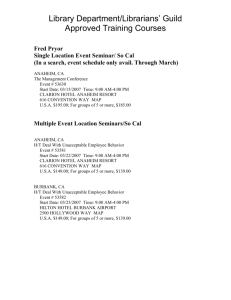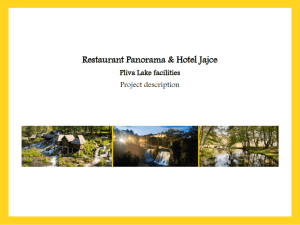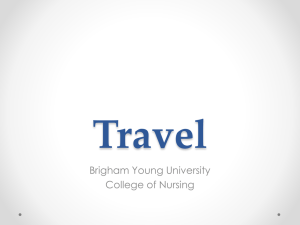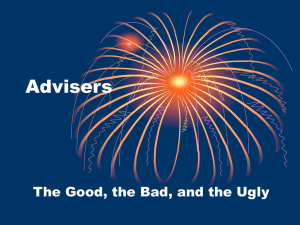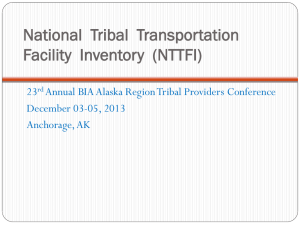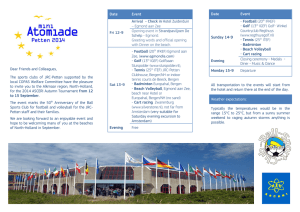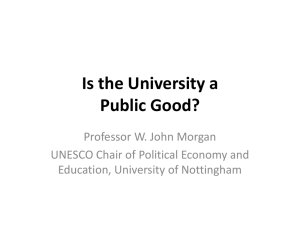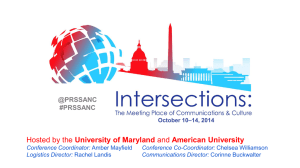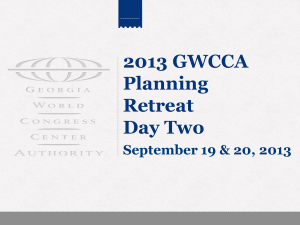2015 ICBSC Presentation Slides - International Collegiate Business
advertisement
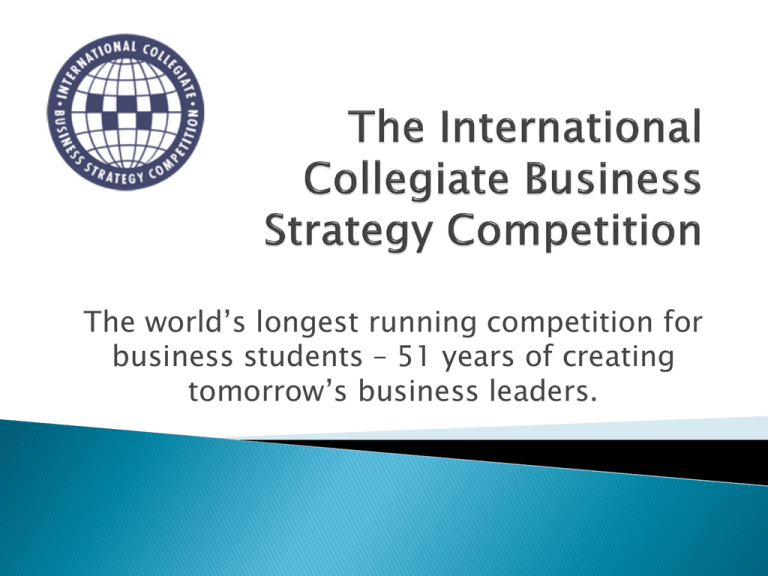
The world’s longest running competition for business students – 51 years of creating tomorrow’s business leaders. In 1964 Dean Weems and the faculty at the University of Nevada decided to create a business competition west of the Mississippi. Nine schools accepted their invitation to participate: Arizona State College (Flagstaff), Arizona State University, Nevada Southern University, University of Nevada, University of Oregon, University of the Pacific, Sacramento State University, Stanislaus State University and Utah State University. The competition began in December 1964 when the first decisions were mailed to the Reno campus for processing. After a series of remote decisions, all teams came to Reno in April 1965 for three days of onsite competition. The competition went very well and enthusiasm was high. Many of the schools requested that the competition become an annual event. The competition was held at the University of Nevada, Reno from 1965 to 1992. It moved to the University of Nevada, Las Vegas in 1993, to San Jose State University in 1995, the University of San Diego in 1999, and California State University, Long Beach in 2011. In 2015 the competition will be hosted by California State University, Long Beach and held at the DoubleTree Suites by Hilton - Anaheim Resort Convention Center Today, the competition is the longest-running and most comprehensive, competition in the world. In 2015 the competition will be in its 51th year! The competition involves student “executive teams” conducting business for five years for a simulated, publicly held international company in direct competition with other companies run by student “executive teams.” Students run their companies by making decisions about their company operations that are input into the simulation computer. Finance -- acquiring the financing required to meet cash obligations, issuing dividends Marketing -- the four P's and sales forecasting Accounting -- using financial statements to understand the company's operations Operations -- expanding operations to meet demand, investing in R&D to bring new products to market Human Resources -- hiring/transferring/laying off sales people and new production workers The Remote Phase: Twelve of the 20 quarterly business decisions are made from the home campus during the remote phase as the team forms its strategies and carries it out over time. During this time, students write both a strategic plan and an annual report for their simulated company. The Intensive on-site phase: This phase occurs in April, where the remaining quarterly decisions are made and students make presentations to the judges serving as their “Board of Directors.” Students have a chance to network and attend the awards banquet. Preparing for the Real World Decision Making Team Building Core Skills Learned Business Analysis Presentation Skills Evaluation and Competition… …is focused on preparing students for POST graduation, giving them practice in running a business without the risks of reality. There’s much to be learned by those who win or maybe more by those who lose. Team Member Job Descriptions Team members organize themselves and assign executive roles commensurate with those found in companies running an international public business. For example: ◦ CEO ◦ CFO ◦ COO ◦ Sr. VP Marketing ◦ Sr. VP Operations Each team files a Corporate Charter with the competition prior to the commencement of competition activities. Charter will identify Corporate name and officers. Over 200 public and private universities have participated in the competition over time ◦ International -- from as far away as Canada, Mexico, the United Kingdom, the United Arab Emirates, and China. ◦ United States -- more than 30 states represented over the years. Multiple “worlds” -- universities may send multiple teams ◦ MBA ◦ Undergraduates Benefits for the Students Opportunities to experience the fast paced business decision-making required by executives of business enterprises in the real world Opportunities to experience the results of their business decisions in a dynamic business simulation Opportunities to accept responsibility for the results of their business decisions Many students have said that this is the best learning experience of their business education The Opportunity to provide the best and brightest business students an opportunity to experience a competitive environment that will test the skills they have learned while studying at your University The Opportunity to compare the competitive business skills of your best and brightest students with those from other Universities The Opportunity to generate excitement and engagement among students enrolled in your program. A recruiting tool that will demonstrate to prospective students that your University provides award winning opportunities for business study A recruiting tool that your student graduate participants can use in employment recruitment opportunities A student performance tool that your University can use to recruit new high quality faculty members Sponsorship Benefits Access to pre-executives running a company (applied education) who have: 1. Diversity experience - international, public = complexities over time, simulation 2. Degree + one more level 3. Evaluated by business executives 4. On the job, their learning curve is smaller than a regular graduate because they have experience 5. These students choose to work harder and challenge themselves beyond a typical semester long course 6. "Pilot in a simulator" vs. book learning Competition Costs ICBSC Registration Fee ◦ $2,000 for one team and an additional $1100 for each additional team from the same campus Transportation costs from your university to Anaheim for the “intensive phase” of the competition. Advisors typically rent a van or hire a shuttle to transport students from and to the airport. Hotel costs -- In 2015 the Competition will be held at the DoubleTree by Hilton -- Anaheim Resort convention Center. The hotel is within a mile of Disneyland Park and Disney's California Adventure® Park. ◦ Students: $155 plus taxes per night (three nights) in a suite room for up to four students sharing a room. ◦ Advisor(s): $125-155 plus taxes per night per night (two to three nights). Food: ◦ Students: Hosted opening evening Social with food and the Awards Banquet. Typically, universities require students to pick up the remaining food and incidentals costs. ◦ Advisors: Hosted opening night Social and the Awards Banquet. In addition, the Competition hosts an advisor lunch with judges. Typically, universities compensate advisors based on per diem university policies. Estimated Cost Illustrations Assumptions: one student team with five members (three men and two women) from Your University and one advisor. Teams may be between four and six students. ◦ Registration cost of $2000 ◦ Transportation -- approximately 500 miles from Your University to the DoubleTree by Hilton Anaheim Convention Center Hotel Competition site. Transport by rented van with unlimited mileage: four days x $60 per day. Gasoline for1000 miles (est. at 18 miles per gallon and $4.00 per gallon) = $223 for gasoline. Assuming greater than 500 miles, the cost of transportation will involve airfare into Southern California TBD for up to six students and an advisor and transportation from the airport to the hotel. ◦ Los Angeles International (LAX) -- approximately 36 miles from the airport to hotel ,John Wayne Airport (SNA) -- approximately 13 miles from the airport to hotel Long Beach (LGB) -- approximately 17 miles from the airport to hotel Rented van with unlimited mileage – three days x $60 per day plus gasoline (est. at 18 mpg and $4.00 per gallon) 100 miles = 6 gallons times $4.00 per gallon = $24. Food: Faculty advisor meals for Thursday while traveling, Friday evening, and Saturday lunch per Your University reimbursement policies Hotel: Two rooms for students for three nights (including taxes) = $1150. One room for faculty advisor for three nights = $575. ◦ ◦ How Have Other Universities Paid the ICBSC Participation Costs? Participating Universities have used various sources to cover their team’s ICBSC participation costs such as: Funds within the University budget for special student projects Funds provided by alumni groups for special student projects Funds provided by corporate sponsors – the Deans Advisory Council Funds from specific student fund-raising projects to pay the costs of the ICBSC competition The International Collegiate Business Strategy Competition Total Enterprise Simulation Student teams become the “Top Management Team” of a simulated company. ◦ You run your company by making decisions ◦ Five years times four quarters = 20 sets of decisions ◦ 10 decisions remote phase ◦ 10 decisions during “on-site” phase An International Simulation Merica, a North American country Second country chosen from ◦ Eastern Europe ◦ Southeast Asia ◦ Latin America Separate economies and demand structures Currency transfers via exchange rates Total Enterprise Simulation As the management team, the student managers are responsible for the whole company Finance dimension Marketing dimension Operations dimension HRM integrated throughout Finance Dimension Financial planning ◦ Project expenses and revenues ◦ Budget capital expenditures ◦ Manage financial structure of the firm Financial decisions ◦ ◦ ◦ ◦ ◦ Short-term bank loans Bond sales & repurchases Stock sales & repurchases Dividend payouts Certificate of deposit investments Marketing Dimension Product Management Sales Office Management Price by area Sales forecasting Advertising by area Product ordering Product introduction Sales force management Marketing research Closing and opening sales Product quality office Product features Production Dimension Production scheduling Production capacity Resource development ◦ Product R&D ◦ Employee Training Strategic Plan, Annual Report and Presentation to Panel of Judges “Our plan was to …” Two Phases Remote – Mid-January to April 11 Team receive start-up files Teams submit 12 quarters of decisions from home schools beginning February 3 thru April 11. ◦ Via internet ◦ Results become available and the basis for the next set of decisions Strategic Plan written and submitted to Competition. Annual Report prepared just before trip to Anaheim CA and due at registration for the on-site intensive phase. Teams create corporate logos ◦ Identifying shirts or name tags with corporate logos for wearing during the on-site phase. ◦ HQ door signs for meeting rooms during on-site. Two Phases On-site, Intensive -- April 23-25, 2015 Travel to Anaheim, CA for intensive phase to arrive no later than afternoon of April 23, 2015 Annual Report turned in at registration Opening night social and general meeting Remainder of decisions (eight quarters) from “Corporate Headquarters” in one of student rooms in the hotel. Presentations to judges serving as Board of Directors Awards Banquet on Saturday, April 25 Most hotel checkouts will be on Sunday, April 26 How are Students Judged? Financial performance ◦ ◦ ◦ ◦ EPS Stock Price ROI Credit Rating Strategic performance Qualitative factors ◦ ◦ ◦ ◦ Strategic Plan Annual Report Team cohesion Presentation during “board meeting” ◦ Market share ◦ Strategic plan implementation Judges are business executives who donate their time (and personal resources) to judge the competition Awards Banquet
